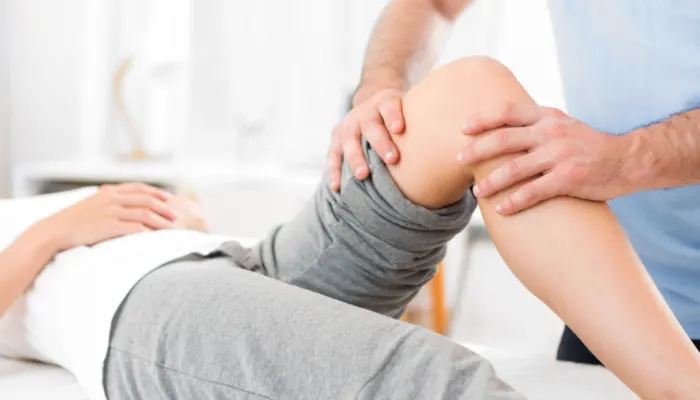If you have an injury or painful musculoskeletal condition that impacts your movement, like lower back pain or neck pain, this question is for you:
Is massage therapy part of your physical therapy routine?
If so… that’s awesome! As a result, you’re on the fast track to healing.
If not… it’s time to consider using massage to supercharge your physical therapy. When used in conjunction, they can reduce pain, improve mobility and help you feel good faster.
Let’s look at the benefits of massage therapy and how this healing therapy could help you.

What is Massage?
Massage therapy involves the rubbing and kneading of muscles and joints to relieve tension, pain and inflammation.
It encourages the healing flow of blood, oxygen and nutrients to soft tissues, which are the tissues that connect, support, or surround other structures and organs in the body. Soft tissues consist of muscles, tendons, ligaments, fascia, nerves, fibrous tissues, fat, blood vessels, and synovial membranes.
Therapeutic massage also nurtures the nervous system, promotes relaxation and restoration and encourages the release of feel-good chemicals to decrease pain.

Benefits of Massage
The health benefits of massage are vast. That’s because massage therapy, and the range of massage techniques used by massage therapists, have the potential to benefit every system in your body.
When you use massage therapy to compliment physical therapy, you can:
Reduce chronic pain
Massage reduces pain by improving microcirculation, vasodilation, oxygenation and nutrient supply to soft tissues. It also stimulates the release of endorphins that reduce pain sensitivity.
Break up scar tissue
Deep tissue massage benefits the connective tissues and layers of muscles. This helps break down adhesions and align collagen fibres, making it useful after surgery and during injury recovery.
Improve range of motion
Massage increases the temperature of soft tissues, releases muscular tension, reduces local swelling and helps to break down restrictive adhesions. Consequently, this may improve range of motion in people recovering from injuries and surgery.
Enhance mobility
As massage begins to improve range of motion, strengthen posture and reduce pain, mobility and dexterity naturally improve. Thankfully, this also lowers the risk of further injuries.
Improve mental health
Massage encourages relaxation and stimulates the release of beneficial neurochemicals that improve mood and mental health. It’s especially useful for when an injury or musculoskeletal condition causes stress, anxiety or depression. Interestingly, this also has a positive effect on blood pressure.

Different Types Of Massage
There are many different types of massage.
Accordingly, each uses specialised techniques to support musculoskeletal health, encourage self-healing and improve wellbeing.
Here are 3 popular types of massage therapy:
Swedish Massage
This relaxing massage uses long, flowing strokes to invoke feelings of calm. It targets superficial layers of muscles to improve oxygenation and blood circulation, remove muscle toxins, enhance flexibility and ease tension.
Deep Tissue Massage
This form of remedial massage targets the deeper layers of muscle and connective tissues. Initially, light pressure is used to warm up the muscles, but the majority of the session will use stronger pressure to get results. It’s great for realigning tissue fibres, breaking down scar tissue and adhesions, easing muscle pain, improving injury recovery and more.
Sports Massage
Ideal for athletes, this type of massage intricately manipulates the muscles to correct physical strain. It’s great for preventing and treating overuse injuries that result from repetitive movements, promoting flexibility and reducing muscle fatigue.
Other types of massage include:
- Lymphatic Drainage Massage
- Prenatal Massage
- Aromatherapy Massage
- Reflexology (specialised foot massage).

Why Massage Therapy Is An Essential Part of Physical Therapy
Physical therapy (a.k.a. physiotherapy) treats disease, injury and musculoskeletal conditions using physical methods, such as exercise and physical movement, rather than with drugs or surgery.
Massage therapy is a specialised form of physical therapy and use direct manual manipulation to facilitate healing. As they treat similar conditions and use complementary techniques, massage is considered an essential part of physical therapy.
However, if you’re unsure exactly how massage can complement physical therapy, here are 3 reasons why they’re a dream team:
-
Faster Healing Time
Physical therapy and massage work together to stimulate the flow of blood, oxygen and nutrients around the body. In combination, these therapies nurture local and systemic healing to give you faster, more long lasting results.
-
Better Range of Motion and Mobility
Both physical therapy and massage can enhance range of motion and mobility; however, using them together can create better range of motion, stability and mobility.
-
More Energy + Less Stress = Reduced Pain
Using physical therapy alongside massage tells your body to produce higher quality energy with fewer stress chemicals. Considering stress triggers inflammatory, this results in reduced pain and a greater sense of calm.
Keen to visit a licensed massage therapist and heal faster?
Click the link below to get started:



